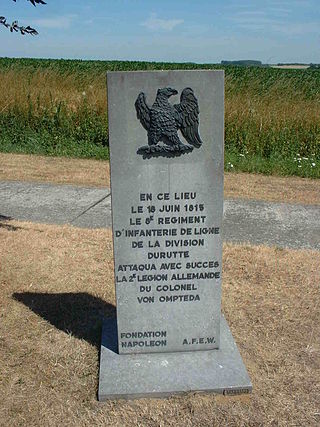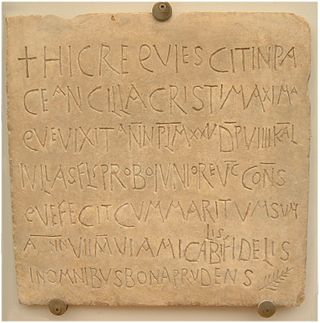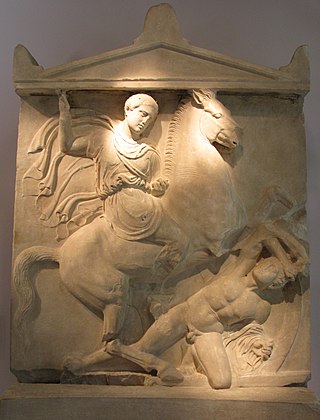Dactylic hexameter is a form of meter or rhythmic scheme frequently used in Ancient Greek and Latin poetry. The scheme of the hexameter is usually as follows :
The elegiac couplet is a poetic form used by Greek lyric poets for a variety of themes usually of smaller scale than the epic. Roman poets, particularly Catullus, Propertius, Tibullus, and Ovid, adopted the same form in Latin many years later. As with the English heroic couplet, each pair of lines usually makes sense on its own, while forming part of a larger work.
Hexameter is a metrical line of verses consisting of six feet. It was the standard epic metre in classical Greek and Latin literature, such as in the Iliad, Odyssey and Aeneid. Its use in other genres of composition include Horace's satires, Ovid's Metamorphoses, and the Hymns of Orpheus. According to Greek mythology, hexameter was invented by Phemonoe, daughter of Apollo and the first Pythia of Delphi.
In poetry, metre or meter is the basic rhythmic structure of a verse or lines in verse. Many traditional verse forms prescribe a specific verse metre, or a certain set of metres alternating in a particular order. The study and the actual use of metres and forms of versification are both known as prosody.
Nonnus of Panopolis was the most notable Greek epic poet of the Imperial Roman era. He was a native of Panopolis (Akhmim) in the Egyptian Thebaid and probably lived in the 5th century CE. He is known as the composer of the Dionysiaca, an epic tale of the god Dionysus, and of the Metabole, a paraphrase of the Gospel of John. The epic Dionysiaca describes the life of Dionysus, his expedition to India, and his triumphant return. It was written in Homeric Greek and in dactylic hexameter, and it consists of 48 books at 20,426 lines.
A spondee is a metrical foot consisting of two long syllables, as determined by syllable weight in classical meters, or two stressed syllables in modern meters. The word comes from the Greek σπονδή, spondḗ, 'libation'.

A caesura, also written cæsura and cesura, is a metrical pause or break in a verse where one phrase ends and another phrase begins. It may be expressed by a comma (,), a tick (✓), or two lines, either slashed (//) or upright (||). In time value, this break may vary between the slightest perception of silence all the way up to a full pause.

A dactyl is a foot in poetic meter. In quantitative verse, often used in Greek or Latin, a dactyl is a long syllable followed by two short syllables, as determined by syllable weight. The best-known use of dactylic verse is in the epics attributed to the Greek poet Homer, the Iliad and the Odyssey. In accentual verse, often used in English, a dactyl is a stressed syllable followed by two unstressed syllables—the opposite is the anapaest.

A stele, or occasionally stela, when derived from Latin, is a stone or wooden slab, generally taller than it is wide, erected in the ancient world as a monument. The surface of the stele often has text, ornamentation, or both. These may be inscribed, carved in relief, or painted.
Iambic pentameter is a type of metric line used in traditional English poetry and verse drama. The term describes the rhythm, or meter, established by the words in that line; rhythm is measured in small groups of syllables called "feet". "Iambic" refers to the type of foot used, here the iamb, which in English indicates an unstressed syllable followed by a stressed syllable. "Pentameter" indicates a line of five "feet".
This is a glossary of poetry.
The following outline is provided as an overview of and introduction to poetry:
A cretic is a metrical foot containing three syllables: long, short, long. In Greek poetry, the cretic was usually a form of paeonic or aeolic verse. However, any line mixing iambs and trochees could employ a cretic foot as a transition. In other words, a poetic line might have two iambs and two trochees, with a cretic foot in between.
Resolution is the metrical phenomenon in poetry of replacing a normally long syllable in the meter with two short syllables. It is often found in iambic and trochaic meters, and also in anapestic, dochmiac and sometimes in cretic, bacchiac, and ionic meters. In iambic and trochaic meters, either the first or the second half of the metrical foot can be resolved, or sometimes both.

Early Christian inscriptions are the epigraphical remains of early Christianity. They are a valuable source of information in addition to the writings of the Church Fathers regarding the development of Christian thought and life in the first six centuries of the religion's existence. The three main types are sepulchral inscriptions, epigraphic records, and inscriptions concerning private life.
Latin prosody is the study of Latin poetry and its laws of meter. The following article provides an overview of those laws as practised by Latin poets in the late Roman Republic and early Roman Empire, with verses by Catullus, Horace, Virgil and Ovid as models. Except for the early Saturnian poetry, which may have been accentual, Latin poets borrowed all their verse forms from the Greeks, despite significant differences between the two languages.

The Grave Stele of Dexileos is the stele of the tomb of an Athenian cavalryman named Dexileos who died in the Corinthian War against Sparta in 394 BC. The stele is attributed to "The Dexileos Sculptor". Its creation can be dated to 394 BC, based on the inscription on its bottom, which provides the dates of birth and death of Dexileos. The stele is made out of an expensive variety of Pentelic marble and is 1.86 metres tall. It includes a high relief sculpture depicting a battle scene with an inscription below it. The stele was discovered in 1863 in the family plot of Dexileos at the Dipylon cemetery in the Kerameikos cemetry of Athens. It was found in situ, but moved during World War II, and is now on display in the Kerameikos Museum in Athens.

The Stele of Arniadas is an Archaic-period funerary stele in Corfu, Greece, found on the tomb of Arniadas, a warrior. It was intended to mark his grave and honour his memory by enumerating his bravery in a battle near the river Arachthos in the location of ancient Amvrakia, modern-day Arta. The stele was found in 1846 at the necropolis of the Corfu Palaiopolis in the suburb of Garitsa, near the Tomb of Menecrates, after a demolition of Venetian fortifications in the area by the British, who at the time ruled Corfu. The date of the stele is early 6th century BC.

CIL 4.5296 is a poem found graffitied on the wall of a hallway in Pompeii. Discovered in 1888, it is one of the longest and most elaborate surviving graffiti texts from the town, and may be the only known love poem from one woman to another from the Latin world. The poem is nine verses long, breaking off in the middle of the ninth verse; a single line in a different hand is written underneath. It is in the collection of the National Archaeological Museum, Naples.
The Latin rhythmic hexameter or accentual hexameter is a kind of Latin dactylic hexameter which arose in the Middle Ages alongside the metrical kind. The rhythmic hexameter did not scan correctly according to the rules of classical prosody; instead it imitated the approximate sound of a typical metrical hexameter by having roughly the same number of syllables and putting word accents in approximately the same places in the line.







